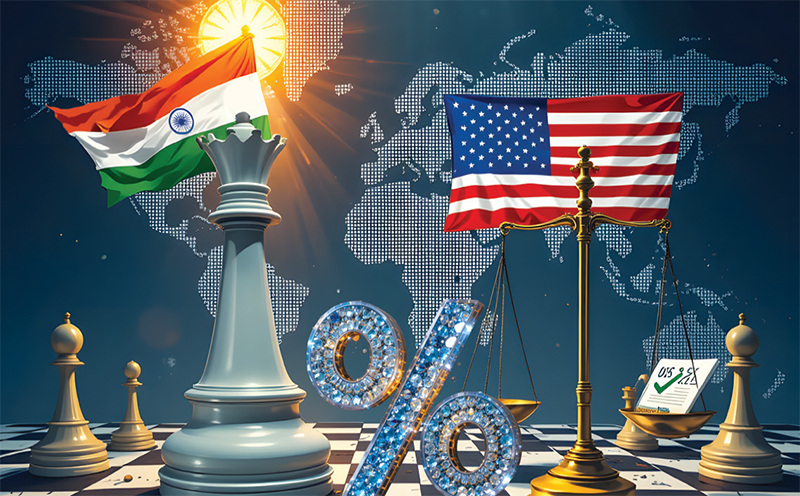Blitz Bureau
NEW DELHI: The tug-of-war between Washington and New Delhi over tariffs has taken a dramatic turn. After US President Donald Trump imposed steep duties on Indian exports — part of a broader attempt to punish New Delhi for continuing discounted oil purchases from Russia — the move faces legal headwinds at home.
A series of US federal court rulings have struck at the very foundation of Trump’s tariff strategy, setting up a Supreme Court showdown that will decide how much power any president has to wage economic war through executive fiat.
New Delhi turns US tariff pressure into global power play, boosted by America’s own courts
For India, caught at the heart of this storm, the developments are an unexpected opening. By holding firm on energy security, cautiously stabilising ties with China, and keeping the diplomatic door open to Washington, New Delhi has transformed tariff pressure into a stage for strategic balancing.
The tariff squeeze
In late August, the Trump administration escalated trade tensions with India, hiking tariffs by up to 50 per cent on key categories of goods. Soon after, Trump urged the European Union to join the campaign with 100 per cent tariffs on China and India, presenting the measures as punishment for helping Moscow weather Western sanctions.
Yet even as Washington doubled down, the White House dangled the possibility of restarting trade talks with New Delhi, signalling that the door to compromise was still open. The contradiction was clear: economic coercion on one hand, outreach on the other.
India, the world’s fastest-growing major economy, refused to blink. Finance officials reiterated that as long as Russian oil remains cheap, India will buy it. Moscow, sensing opportunity, raised its seaborne exports to Asia, making India one of its top customers. In May to July alone, India purchased nearly 38 per cent of Russia’s crude exports. Energy security, Delhi insisted, was non-negotiable.
Courts check Presidential power
Just as tariffs began to bite, America’s legal system intervened. In May, the US Court of International Trade ruled that Trump had overstepped his authority under the International Emergency Economic Powers Act (IEEPA), declaring most emergency tariffs unlawful.
That decision was largely upheld on August 29 by the Federal Circuit, which confirmed the President cannot impose “unbounded” duties under IEEPA. On September 9, the US Supreme Court agreed to hear the case on an expedited basis, with arguments scheduled for November. Until then, tariffs remain in effect, but their future hangs by a thread.
The rulings do not automatically touch tariffs imposed under other statutes, such as Section 232 on national security or Section 301 on unfair trade practices. But they strike at the legal core of Trump’s most sweeping tariff weapon, casting uncertainty over any IEEPA-based duties — including those levied against India.
India’s strategic play
For New Delhi, the court challenge weakens Washington’s hand and strengthens its own. India is now free to highlight the legal fragility of US tariffs while pressing forward with its independent course.
That means Indian refiners will continue to buy Russian oil as long as discounts make it economical. Prime Minister Narendra Modi and President Xi Jinping have reopened dialogue channels, exploring confidence-building measures even as the border remains tense. By reviving limited cooperation, India signals a pragmatic reset with China.
At the same time, by keeping trade talks alive with Washington, Delhi signals it is not turning away from the West but demanding engagement on firmer terms. This three-pronged approach — resilient energy policy, tactical stability with China, and guarded openness to the US — positions India as an autonomous power capable of converting pressure into posture.
What comes next
Three developments will shape the road ahead. The first is the Supreme Court’s November hearing. If the justices strike down Trump’s IEEPA tariffs, Washington will need new, narrower tools, which could push the US into targeted negotiations with India instead of broad-brush punishment.
Second, Europe’s response will matter. If Brussels resists US lobbying for 100 per cent tariffs on India, it opens a vital trade escape hatch for Delhi, deepening its footprint in the EU market.
Third, oil economics remain central. As long as Russian barrels remain discounted, India’s calculus will not change. If discounts shrink, Delhi may recalibrate; if they widen, the Russia – India energy corridor will only grow stronger.
India’s rising leverage
The irony is stark. By weaponising tariffs to pressure India, Washington may have inadvertently elevated New Delhi’s global profile. Today, India enjoys moral authority by defending sovereign choices on energy security, diplomatic weight by engaging Russia, China and the US on its own terms, and reputational capital as a growth hub every major power seeks to court — even when they squeeze it.
Whether the US tariffs survive the Supreme Court or collapse under judicial review, one reality is already clear: India will not be cornered. Instead, it stands courted by all, its leverage amplified by the very pressure meant to contain it.



